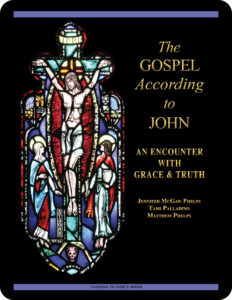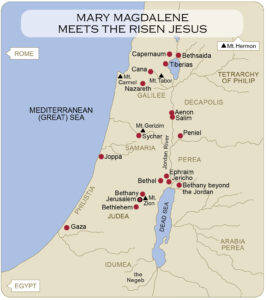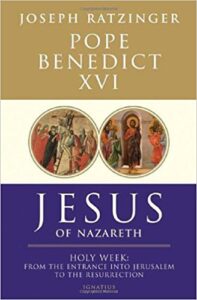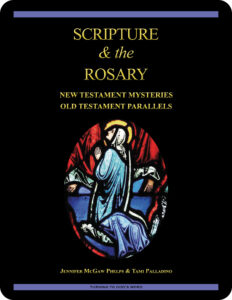 The Gospel According to John:
The Gospel According to John:
An Encounter with Grace & Truth
Lesson 24 Woman, Why Are You Weeping?
the Gospel According to John 20:1–18
Revised Standard Version Catholic Edition (RSVCE)*
New American Bible Revised Edition (NABRE)*
Catechism of the Catholic Church
Rosarium Virginis Mariae (Rosary of the Virgin Mary)
ex libris (in our library)
glossary for the Gospel According to John
cross references in the Gospel According to John
next lesson: Do You Love Me?
This material coordinates with Lesson 24 on pages 126–129 in The Gospel According to John: An Encounter with Grace & Truth.
“Now Jesus did many other signs in the presence of the disciples, which are not written in this book; but these are written that you may believe that Jesus is the Christ, the Son of God, and that believing you may have life in his name.”—the Gospel According to John 20:30–31
welcome to our in-depth study of the Gospel According to John
We invite interested groups and individuals to check out the sample first lesson from this 25- lesson Turning to
lesson Turning to  God’s Word Catholic Bible study. These online study pages link to our free lesson videos, as well as to a glossary and cross references in the biblical text. Other study aids include maps, additional commentary, and prayers based on the primary Scripture in each lesson. The Gospel According to John: An Encounter with Grace & Truth has been granted an imprimatur and can be purchased from our website shop. If you have a Bible-related question or comment, click on one of the “ask us your question” or “what do you think” buttons on any online study page.
God’s Word Catholic Bible study. These online study pages link to our free lesson videos, as well as to a glossary and cross references in the biblical text. Other study aids include maps, additional commentary, and prayers based on the primary Scripture in each lesson. The Gospel According to John: An Encounter with Grace & Truth has been granted an imprimatur and can be purchased from our website shop. If you have a Bible-related question or comment, click on one of the “ask us your question” or “what do you think” buttons on any online study page.
open with prayer
It’s always wise to begin any Bible study with prayer, whether reading the Scriptures alone or meeting with others in a discussion study group. You can pray using your own words or use one of the opening prayers on our website. We especially like the following:
Lord Jesus, you promised to send your Holy Spirit
to teach us all things.
As we read and study your word today,
allow it to touch our hearts and change our lives. Amen.
let’s review—the Gospel According to John 19:17–42
In Lesson 23 It Is Finished, Jesus carries his cross to Golgotha, where he is crucified between two others. Pilate has a sign reading “Jesus of Nazareth, King of the Jews” placed over the cross. Although the Jewish leaders object, Pilate refuses to change the sign. The soldiers divide Jesus’ clothing. Among those at the Crucifixion are Jesus’ Mother and the disciple whom he loved, and Jesus gives them into each other’s care. After drinking some common wine, Jesus bows his head and gives up his spirit. In the Fourth Gospel, Jesus’ Crucifixion happens on the day of Preparation for the sabbath. Soldiers don’t break Jesus’ legs because he’d already dead, but one pierces Jesus’ side out of which flow blood and water. Joseph of Arimathea, a secret disciple, and Nicodemus, take Jesus’ body to be buried.
map notes—what’s going on at the tomb?
The Gospel According to John 20:1–2 describes Mary Magdalene going early to the tomb on Sunday  morning and finding the stone removed. She assumes that someone has taken Jesus’ body, and runs to tell the disciples. It’s significant that Simon Peter and the disciple whom Jesus loved immediately go to the tomb to see for themselves. Their act indicates more than that they simply didn’t believe Mary Magdalene. In Jewish culture at that time, women were prohibited from serving as legal witnesses. The disciples well may have believed Mary Magdalene was telling the truth, but in order for others to accept the story, two male witnesses were required. What things previously have occurred in the Gospel According to John that you can point to as evidence that God doesn’t have a problem with the witness of women? Click on the image (right) to enlarge the map, which appears on page 128 in The Gospel According to John: An Encounter with Grace & Truth.
morning and finding the stone removed. She assumes that someone has taken Jesus’ body, and runs to tell the disciples. It’s significant that Simon Peter and the disciple whom Jesus loved immediately go to the tomb to see for themselves. Their act indicates more than that they simply didn’t believe Mary Magdalene. In Jewish culture at that time, women were prohibited from serving as legal witnesses. The disciples well may have believed Mary Magdalene was telling the truth, but in order for others to accept the story, two male witnesses were required. What things previously have occurred in the Gospel According to John that you can point to as evidence that God doesn’t have a problem with the witness of women? Click on the image (right) to enlarge the map, which appears on page 128 in The Gospel According to John: An Encounter with Grace & Truth.
 more contrasts (55:17)
more contrasts (55:17)
Throughout the Fourth Gospel, the Evangelist has relied on contrasts to emphasize  his message about who Jesus is and what Jesus came to accomplish. In the video for this lesson, Turning to God’s Word author Matthew Phelps discusses the two most obvious contrasts apparent in the twentieth chapter in the Gospel According to John. The one that scholars most frequently comment on is the contrast between Peter and the disciple whom Jesus loves, and that will continue into the final chapter. Another contrast is between the behavior of the two disciples at the tomb and the behavior
his message about who Jesus is and what Jesus came to accomplish. In the video for this lesson, Turning to God’s Word author Matthew Phelps discusses the two most obvious contrasts apparent in the twentieth chapter in the Gospel According to John. The one that scholars most frequently comment on is the contrast between Peter and the disciple whom Jesus loves, and that will continue into the final chapter. Another contrast is between the behavior of the two disciples at the tomb and the behavior  of Mary Magdalene. For more information, read “At the Empty Tomb” on page 129 in The Gospel According to John: An Encounter with Grace & Truth.
of Mary Magdalene. For more information, read “At the Empty Tomb” on page 129 in The Gospel According to John: An Encounter with Grace & Truth.
The Scripture ranges for the videos that accompany this Catholic Bible study match the Scripture ranges for the sets of questions in The Gospel According to John: An Encounter with Grace & Truth. You can follow along with the video overview as Turning to God’s Word author Matthew Phelps discusses Lesson 24, “Woman, Why Are You Weeping?” on pages 125–129 in the study book.
WHAT DO YOU THINK ABOUT weeping as a sign of weakness?
Although weeping traditionally is considered a sign of weakness in most cultures, the weeping described in the Fourth Gospel appears to be connected more to strength.
? For what reason might Mary Magdalene have stayed behind to weep at Jesus’ empty tomb after Peter and John leave?
weep at Jesus’ empty tomb after Peter and John leave?
? How does Mary Magdalene’s relationship with Jesus differ from the relationship the disciples have with Jesus?
? How is Mary Magdalene rewarded for her devotion?
? Jesus previously has been shown weeping outside the tomb of Lazarus. What point might the Evangelist have been trying to emphasize when he chose to include that detail? If necessary, refer to the Gospel According to John 11:1–44.
sorrow & joy
In this section of the Fourth Gospel, the Evangelist returns to the theme of sorrow turning to joy that Jesus spoke of in the Gospel According to John 16:22. If your memory is a bit fuzzy, you can review the sidebar “Sorrow & Joy” on page 105 in The Gospel According to John: An Encounter with Grace & Truth. Learn how the Sorrowful and Joyful Mysteries of the Rosary are connected to passages from the Bible in our Turning to God’s Word Catholic Bible study Scripture & the Rosary: New Testament Mysteries, Old Testament Parallels. Free digital lessons from that study rotate on our website throughout the liturgical year. The Joyful Mysteries—Lesson 7 The Angel Gabriel Was Sent to a Virgin through Lesson 11 All Who Heard Him Were Amazed—only are available during the liturgical season of Advent. The Sorrowful Mysteries—Lesson 12 He Began to Be Sorrowful through Lesson 16 There They Crucified Him—only are available during the liturgical season of Lent.
throughout the liturgical year. The Joyful Mysteries—Lesson 7 The Angel Gabriel Was Sent to a Virgin through Lesson 11 All Who Heard Him Were Amazed—only are available during the liturgical season of Advent. The Sorrowful Mysteries—Lesson 12 He Began to Be Sorrowful through Lesson 16 There They Crucified Him—only are available during the liturgical season of Lent.
 Ascension—you could look it up in our archives
Ascension—you could look it up in our archives
Mary Magdalene fostered a close relationship with Jesus and watched him die on the cross. She met the risen Jesus early on Easter morning, but Jesus had not yet ascended at that time. To learn more about the Ascension, read “Rising & Ascending” on page 127 in The Gospel According to John: An Encounter with Grace & Truth, and Lost in Translation, an online column in which Turning to God’s Word author Matthew Phelps helps readers connect with ideas expressed in the original languages of the Scriptures. New Lost in Translation entries are posted on Mondays, and past entries are archived on our website. Contact us if you’d like to receive Lost in Translation by email every week.
 the popes inspire us—the first recorded witness
the popes inspire us—the first recorded witness
The papal quote on page 128 in The Gospel According to John: An Encounter with Grace & Truth is by Pope Benedict XVI. In this brief commentary, he looks at Mary Magdalene’s importance as the first recorded witness to Jesus’ Resurrection, something that led the early Church fathers to give her the title “Apostle of the Apostles.” What woman previously mentioned in the Fourth Gospel often is referred to as the first apostle, and how are she and Mary Magdalene similar?
biblical vocabulary—Rabboni
The Hebrew word “Rabboni” by which Mary Magdalene addresses the risen Jesus is defined in the Gospel According to John 20:16 as “Teacher.” While this is accurate, the title carries with it great honor and was used to address a spiritual master.
ex libris—learn more about Jesus’ Passion, death & Resurrection
 In Jesus of Nazareth: Holy Week, the second of a three-part series based on information about Jesus found in the
In Jesus of Nazareth: Holy Week, the second of a three-part series based on information about Jesus found in the  Gospels, Pope Benedict XVI looks at the decisive events and sayings that are the focus
Gospels, Pope Benedict XVI looks at the decisive events and sayings that are the focus  of Jesus’ last week on earth. The Scripture covered begins with Jesus’ entrance into Jerusalem and continues through the time of his Resurrection. Read excerpts and learn more about all three volumes of Jesus of Nazareth and other works related to Bible study at ex libris—main bookshelf.
of Jesus’ last week on earth. The Scripture covered begins with Jesus’ entrance into Jerusalem and continues through the time of his Resurrection. Read excerpts and learn more about all three volumes of Jesus of Nazareth and other works related to Bible study at ex libris—main bookshelf.
for additional reflection
The Gospel According to John 20:8 records that when the disciple Jesus loved looked into the empty tomb “he saw and believed.” This is a powerful statement of the Evangelist’s faith, but it fails to specify exactly what it was that he believed. The following questions are designed to help readers begin to form their own thoughts and ideas related to the Gospel According to John 20:1–18. For more reflection questions, refer to the introduction to Lesson 24 on page 126 in The Gospel According to John: An Encounter with Grace & Truth.
 ? Consider exactly what it was that John believed when he looked into the empty tomb.
? Consider exactly what it was that John believed when he looked into the empty tomb.
? What do you believe when you read this biblical account?
? What obstacles exist as stumbling blocks for belief?
? What is the difference between “faith” and “belief,” and which of these English words might best describe John’s experience at the empty tomb?
the best Catholic commentary about Scripture
 To find out more about how Church teaching is supported by Scripture passages in The Gospel According to John: An Encounter with Grace & Truth, check out the Index of Citations in the Catechism of the Catholic Church. Links to the primary Scripture passages in the lesson (Revised Standard Version Catholic Edition [RSVCE*]) and relevant paragraphs in the Catechism are provided here. Not every passage in the biblical text for this study is referenced in a Catechism paragraph, however.
To find out more about how Church teaching is supported by Scripture passages in The Gospel According to John: An Encounter with Grace & Truth, check out the Index of Citations in the Catechism of the Catholic Church. Links to the primary Scripture passages in the lesson (Revised Standard Version Catholic Edition [RSVCE*]) and relevant paragraphs in the Catechism are provided here. Not every passage in the biblical text for this study is referenced in a Catechism paragraph, however.
the Gospel According to John 20:1—paragraph 2174
the Gospel According to John 20:2—paragraph 640
the Gospel According to John 20:5–7—paragraph 640
the Gospel According to John 20:6—paragraph 640
the Gospel According to John 20:7—paragraph 515
the Gospel According to John 20:8—paragraph 640
the Gospel According to John 20:11–18—paragraph 641
the Gospel According to John 20:13—paragraph 640
the Gospel According to John 20:14–15—paragraphs 645, 659
the Gospel According to John 20:16—paragraph 645
the Gospel According to John 20:17—paragraphs 443, 645, 654, 660, 2795
ways our glossary might prove helpful
In addition to providing extra information about geographical locations, our glossary also points out  persons and places mentioned in the biblical text under multiple names or spellings. If you can remember a name but aren’t sure in which lesson it shows up, you can find it in the glossary, which lists every proper noun that appears in the primary biblical text for The Gospel According to John: An Encounter with Grace & Truth.
persons and places mentioned in the biblical text under multiple names or spellings. If you can remember a name but aren’t sure in which lesson it shows up, you can find it in the glossary, which lists every proper noun that appears in the primary biblical text for The Gospel According to John: An Encounter with Grace & Truth.
to learn more, read more Scripture
If you’re having difficulty with a passage of Scripture, it can be helpful to read the relevant  cross references—but looking these up can take time. To make that easier, we’ve compiled the cross references from the Revised Standard Version Second Catholic Edition (RSV2CE)—the translation that we reprint in our study books. That list can be found at the top of every online study page accompanying this study, and it includes links to each of the cross references in the primary biblical text for The Gospel According to John: An Encounter with Grace & Truth.
cross references—but looking these up can take time. To make that easier, we’ve compiled the cross references from the Revised Standard Version Second Catholic Edition (RSV2CE)—the translation that we reprint in our study books. That list can be found at the top of every online study page accompanying this study, and it includes links to each of the cross references in the primary biblical text for The Gospel According to John: An Encounter with Grace & Truth.
don’t forget about our indexes & extra online material

 If you’re trying to locate information about a specific Scripture passage, you can look it up in the index at the back of the study book or sample lesson. If you want to find a particular commentary, you can look up its title in the topics index. To learn more about another book of the Bible for which there’s a Turning to God’s Word study, visit the online study directories to read the commentaries and watch any accompanying videos. Finally, if you have a question or would like to make a comment about any of our studies, you can use one of the “ask us your question” or “what do you think” buttons to email our authors.
If you’re trying to locate information about a specific Scripture passage, you can look it up in the index at the back of the study book or sample lesson. If you want to find a particular commentary, you can look up its title in the topics index. To learn more about another book of the Bible for which there’s a Turning to God’s Word study, visit the online study directories to read the commentaries and watch any accompanying videos. Finally, if you have a question or would like to make a comment about any of our studies, you can use one of the “ask us your question” or “what do you think” buttons to email our authors.
ex libris—Church documents & books about religious topics
You can find links to magisterial documents referred to in Turning to God’s Word Catholic Bible studies  at ex libris—magisterial documents. This page includes a listing of significant recent encyclicals as well as a number of historical Church documents. Recommended books related to Scripture study can be found at ex libris—main bookshelf.
at ex libris—magisterial documents. This page includes a listing of significant recent encyclicals as well as a number of historical Church documents. Recommended books related to Scripture study can be found at ex libris—main bookshelf.
wondering how to pronounce some of these words?
The following link is to a reading from the New International Version (NIV) Bible. To listen, click on the audio icon above the printed text. Although not taken from the translations used in our study materials, the NIV reading provides an audio guide to pronunciation of words in this lesson’s primary biblical text. A close online version of the translation of the Bible used in Catholic liturgy in the United States as well as an audio guide for daily Mass readings for the current month can be found on the website of the United States Conference of Catholic Bishops (USCCB).
the Gospel According to John 20:1–18 (NIV)
 close with Bible-based prayer related to this lesson
close with Bible-based prayer related to this lesson
Many of our Catholic study groups like to conclude their discussions with a prayer based on the scriptural focus of their lesson, and some participants include Scripture-specific prayer in their individual study. If you’re uncomfortable composing your own Bible-based prayers, you can follow our four easy steps, or you can use the following prayer based on this lesson’s text from the Gospel According to John.
God our Father, you share eternal life with us
through the mysteries of faith
revealed by your Son.
Grant us an increase in the joy we experience
in proportion to the strength of our faith.
We ask this through Jesus Christ, our Lord. Amen.
Lesson 25 Do You Love Me?—the Gospel According to John 20:19—21:25
Lesson 23 It Is Finished—the Gospel According to John 19:17–42
you also may like our study of Scripture & the Rosary (digital only)
 Scripture & the Rosary: New Testament Mysteries, Old Testament Parallels, a 26-lesson Catholic Bible study with an imprimatur, looks at the biblical foundations of the Rosary. The study includes lessons on Pope St. John Paul II’s Rosarium Virginis Mariae (Rosary of the Virgin Mary), the Apostles’ Creed, and the Luminous Mysteries as well as the original 15 Mysteries of the Rosary. Color photographs of stained glass windows depict key scenes in the lives of Jesus and Mary. Free digital lessons rotate throughout the year on our website.
Scripture & the Rosary: New Testament Mysteries, Old Testament Parallels, a 26-lesson Catholic Bible study with an imprimatur, looks at the biblical foundations of the Rosary. The study includes lessons on Pope St. John Paul II’s Rosarium Virginis Mariae (Rosary of the Virgin Mary), the Apostles’ Creed, and the Luminous Mysteries as well as the original 15 Mysteries of the Rosary. Color photographs of stained glass windows depict key scenes in the lives of Jesus and Mary. Free digital lessons rotate throughout the year on our website.
start a Turning to God’s Word Bible study
 Thank you for your interest in The Gospel According to John: An Encounter with Grace & Truth.
Thank you for your interest in The Gospel According to John: An Encounter with Grace & Truth.  Information about beginning a Turning to God’s Word Bible study can be found at start a Bible study. Tami, Matthew, and I are available to answer questions and offer support. Contact us if you’d like to start one of our studies or have your schedule listed with other TtGW study groups on our website. —Jennifer
Information about beginning a Turning to God’s Word Bible study can be found at start a Bible study. Tami, Matthew, and I are available to answer questions and offer support. Contact us if you’d like to start one of our studies or have your schedule listed with other TtGW study groups on our website. —Jennifer
*There are seven deuterocanonical books in the Old Testament—the Books of Tobit, Judith, Wisdom, Sirach, Baruch, and First and Second Maccabees, as well as some passages in the Books of Esther and Daniel. Protestants usually refer to these works as “apocryphal,” a word that means “outside the (Protestant) canon” because they’re excluded from most Protestant Bibles. The word “deuterocanonical” means “second canon”; Catholics use that word to refer to any section of the Catholic Old Testament for which there are no extant, or existing, Hebrew manuscripts. All of the deuterocanonical books appear in the Septuagint, the earliest remaining versions of which date to the 1st century B.C. This Greek translation of the Old Testament was in common use by Jews at the time of Jesus. Learn more by reading How Do Catholic & Protestant Bibles Differ?
Turning to God’s Word printed Bible studies use the 2006 Revised Standard Version Second Catholic Edition (RSV2CE) translation for all Scripture references except those to the Psalms, which are taken from The Abbey Psalms and Canticles, prepared by the Benedictine monks of Conception Abbey and published in 2020 by the United States Conference of Catholic Bishops (USCCB). All Scripture links for the online study pages for The Gospel According to John: An Encounter with Grace & Truth are to the 1966 Revised Standard Version Catholic Edition (RSVCE) translation. The New International Version (NIV) audio recordings follow the same chapter and verse numbering as the RSV Catholic translations, but the NIV translation doesn’t include the deuterocanonical books and passages.
The 1966 RSVCE uses archaic pronouns and verb forms such as “thee,” “thou,” “didst” in the Psalms and in direct quotations attributed to God. The 2006 RSV2CE replaces these with more accessible English. The few significant translation changes in the RSV2CE include rendering almah as “virgin” in the Book of Isaiah 7:14 and restoring the term “begotten” in the Gospel According to John 3:16.
Numbering varies for some passages in this Bible study. Turning to God’s Word studies (print and digital) follow the numbering in the Revised Standard Version Catholic translations (RSV2CE and RSVCE). Discrepancies in the New American Bible Revised Edition (NABRE) are noted in the Index of Scripture Citations in the study book and the online sample.
 You can learn more about the Psalms by viewing a sample lesson from the Turning to God’s Word Catholic Bible study Sing a New Psalm: Communicating with God Through the Prayers of the Church—Volume I: Lauds & Vespers. The second part of that study, Sing a New Psalm: Communicating with God Through the Prayers of the Church—Volume II: Vigils, Day Prayer & Compline, is scheduled for publication in 2025. Some verse numbers may vary in different translations of the Psalms.
You can learn more about the Psalms by viewing a sample lesson from the Turning to God’s Word Catholic Bible study Sing a New Psalm: Communicating with God Through the Prayers of the Church—Volume I: Lauds & Vespers. The second part of that study, Sing a New Psalm: Communicating with God Through the Prayers of the Church—Volume II: Vigils, Day Prayer & Compline, is scheduled for publication in 2025. Some verse numbers may vary in different translations of the Psalms.
